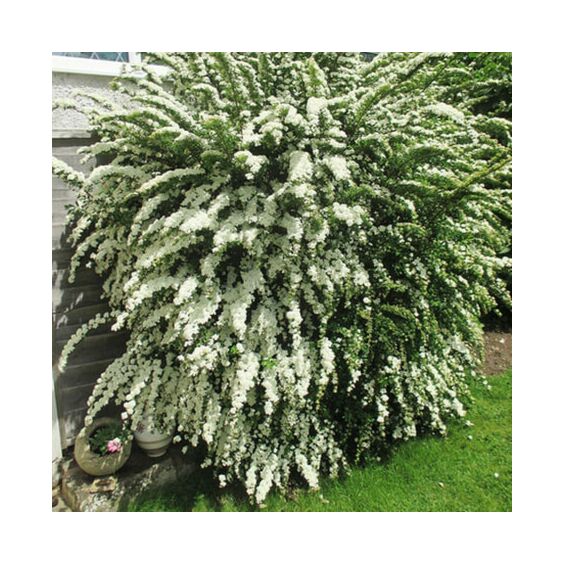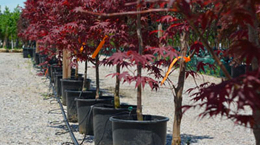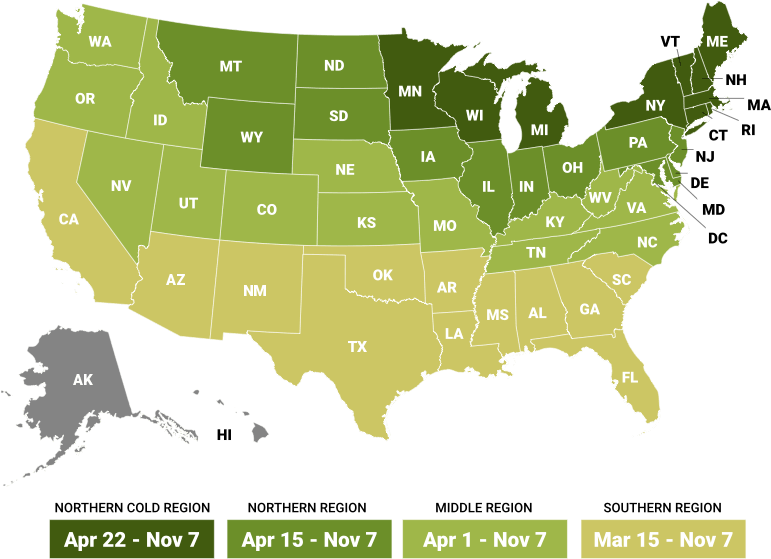
Growing zones
See Zone Map >Status: In stock
Design an Elegant Garden with McKay Nursery Here at McKay Nursery, we provide the right materials to create an elegant garden. Our nursery in Waterloo, Wisconsin, houses a wide collection of hardy plants, including the eye-catching Snowmound spirea. Order your very own Snowmound spirea today and don't forget to add on a one-year warranty with your purchase!
For more information, contact us at [email protected] or call us at 920-478-2121.
- Sun, Part Sun/Shade
Mature Plant Size (H x W): 4-5' x 4-5'
Bloom Season: Spring
- Attracts Bees
- Deer Resistant
- Drought Tolerant
- Salt Tolerant
- Stone Mulch
- Attracts Butterflies
- Cut Flower
- Attracts Pollinators
Planting & Care for Deciduous Shrub – Snowmound Spirea (Spiraea nipponica 'Snowmound')
Preparation
- Very hardy, these shrubs prefer full sun in which stocky shoots flower well and colored-leaved varieties develop vivid hues.
- Spirea thrives in a wide range of well-drained soils (e.g., clay soil and sandy soil) but dislikes dry or very alkaline conditions. Improve sandy patches by digging in plenty of rotted organic matter.
- Works as informal hedges or mass planting along borders in the landscape.
- White flowers occur in late spring to early summer and completely cover the plant on the prior year's wood.
- Plant in March to April or October to November.
- Prune from May to September.
- Encourage robust growth by introducing gentle bone meal into the root area in spring and fall.
- Remove faded flower clusters to extend flowering.
Opening Plant Material
- Bare Root: Cut open the bundle (top and roots are tied) and separate all the plants. Soak roots in buckets of water until planted. Each plant type will be labeled separately for identification. Keep the roots from full sun since they should never dry out. Keep roots covered. All bare-root plants must be trimmed when planted.
- Containers: Completely saturate all container plants by putting them in a larger water container until bubbling stops. Remove the plant, then dig a hole no deeper than the depth of the container, ensuring it’s wider on the sides by an additional 6” or more.
Planting Bare Root
- Plant bare root in fall. A good indicator of whether you can still plant is if the ground is still workable. If a hard frost is expected, hold off on planting.
- Dig a hole at least 6" wider and the same depth as the root mass. The crown or graft of the plant should be slightly higher than ground level where it was grown at the nursery.
- Trim off the broken roots and branches.
- Place fertilizer packets in the hole (if purchased). Do not place other fertilizers in the planting hole. *Use Our Recommended Fertilizer.
- Spread the roots and fill halfway with soil, then water until the soil settles completely, saturating the soil and planting pit.
- Re-adjust the plant and fill the hole with the rest of the soil.
- Backfill the balance of the soil and water well.
Planting Containers
- Plant in March to April or October to November.
- Dig a hole no deeper than the depth of the container and 6" or wider on the sides.
- Slide the plant from the pot by tapping on the bottom of the pot.
- With a shovel or knife, trim the bottom 2" off the root ball for plants in plastic containers.
- Rotate the plant to the proper position. Never lift or move plants by the tops.
- Place the root ball in the hole.
- Adjust the plant height so the root crown is slightly higher than the ground.
- Notice where the base of the trunk flares out from the tree. This is called the root flare. This root flare should show when the tree is planted. Add soil under the ball so the root flare is exposed if necessary.
- Place fertilizer packets into the bottom of the hole (if purchased). *Use Our Recommended Fertilizer.
- Backfill the hole with soil, ensuring the top of the root ball is visible and slightly higher than the soil around it.
- Firm the soil around the plant. Water well to settle soil around the root ball.
- Check out our Planting & Handling Guide for additional planting instructions and illustrations.
Pruning - After Planting
- Bare Root: Prune ALL bare root plants to reduce transplant shock and ensure successful planting. Pruning should occur as soon as possible, before or after planting, and with sharp pruning shears.
- Containers: Although it’s not essential after planting, light pruning can help shape a Spirea Snowmound shrub. Doing so removes any broken branches from shipping or thins out a heavily branched plant to assist in the transplanting process and the appearance of your new planting.
Pruning - Throughout the Season
- Prune from May to September.
- For spring and summer flowering shrubs that flower on older shoots – cut out from the base one older stem in three when blooms fade.
- For summer flowering varieties that bloom on the current year shoots – shorten all stems to 4 inches from the base from early to mid-spring.
- Rejuvenate tall, old, woody varieties making little new growth by cutting all shoots to within 12 inches of the base in early spring.
Watering - After Planting
- Plants typically take approximately 6 weeks to establish new roots in your soil. During this period, water plants as often as every 2-4 days at the start and at least a minimum of once per week.
- Beyond the six-week establishment period, water once per week unless rain occurs.
- Remember to check soil moisture by sticking your finger into the soil around 3”.
Watering - Throughout the Season
- After the first season, plants should only be watered during extended periods without rain.
- How do you know if your plants need water? The easiest way to tell is to touch the soil around the roots. If it is moist, there is no need to water. If it’s dry, give it a good soak with the hose end (no nozzle), watering the soil only, not the leaves.
- Same as after planting, stick your finger into the soil around 3” to check soil moisture.
Frequently Asked Questions
What is the best growing zone for Spirea Snowmound?
How do you propagate Spiraea Snowmound (Spiraea nipponica 'Snowmound')?
Ground layering starts by choosing a long stem flexible enough to lie flat on the ground. Keep the stem attached to the mother plant, then remove its leaves and scrape away at the stem to open it up.
Once the stem is in contact with the ground, bend the stem until the scraped area reaches a small trench 1-inch deep into the ground. Then, secure the stem to the ground to keep it stable.
Cover the stem with soil, water it gently, and allow several months for root development. Once rooted, you can relocate and transplant it to a different spot.
For softwood cuttings, cut healthy stems 10 to 12 inches in length. Then remove the lower leaves from the stem, dip the cutting in the rooting hormone, and plant four or five cuttings in a 6-inch pot filled with moist but well-drained soil.
Cover the cuttings with a plastic bag and place them in a spot with dappled sunlight, regularly checking to ensure the soil remains moist. New growth should emerge in approximately a month.
For hardwood cuttings, trim both the bottom and top stem just above the leaf node. Place the cutting in soil with a depth of around 6 inches. Keep the soil moist.
Perform hardwood cuttings only in winter. You should see signs of emerging growth from the cutting in the following spring.
Does Snowmound spirea need overwintering?
What pests are common to Snowmound spirea?
What diseases are common to Snowmound spirea?
Planting & Handling Help
Download our Planting and Handling Guide below to plan for a successful arrival and install of your plants. Be sure to water all plants as soon as they arrive and every day until you’re ready to plant. Keep any bare root bundles in a shady, cool spot with the roots covered at all times.


Learn More
Watch our videos on handling bare root plants, how your order is prepared for shipment and more.


Plant Sizing
What is the difference between Containers, Grow Bags, Bare Root, and Balled & Burlap (B&B)?
Shipping Times


Our FedEx and local shipping times depend on two factors, one is by the region and the second is the type of product being shipped. For example, small fruits are only shipped in spring, but majority of our perennials are shipped from spring until fall. Keep in mind the dates below act as a general guide. Due to unpredictable weather, staffing, inventory and industry demands these timelines can change. Therefore, we cannot guarantee any of these times.
Shipping Dates by Region*
Northern Cold Region: April 22nd - November 7th
Northern Region: April 15th - November 7th
Middle Region: April 1st - November 7th
Southern Region: March 15th - November 7th
Local Delivery (small radius from Waterloo, WI): April 22nd - November 7th
Shipping Dates by Season*
Spring Shipping: Region Start Date (above) - May
Fall Shipping: September - November
Due to unpredictable weather, these times may vary. Some varieties are exceptions due to heat and plant health reasons. Enter your shipping zip code at the top of this page and be sure to check the shipping information on each product before you add it to your cart. If the product is too large or restricted in your state, you will not be able to checkout with that item in your cart.
